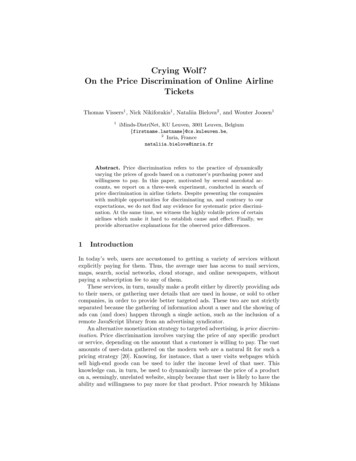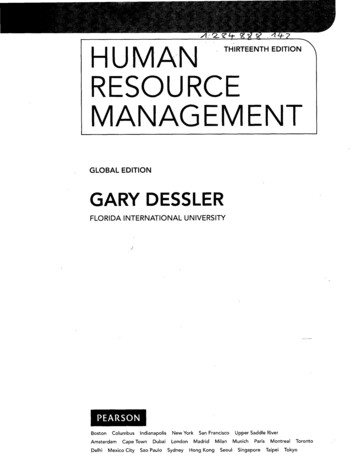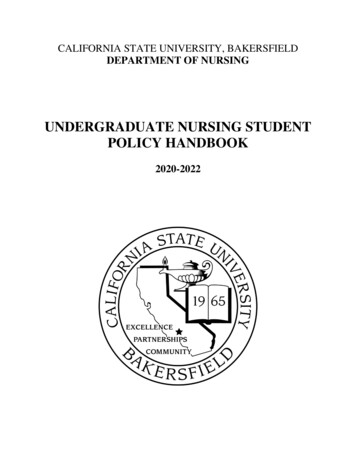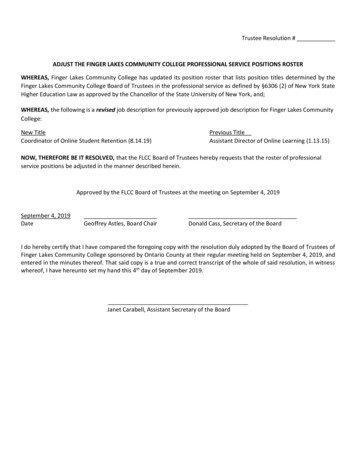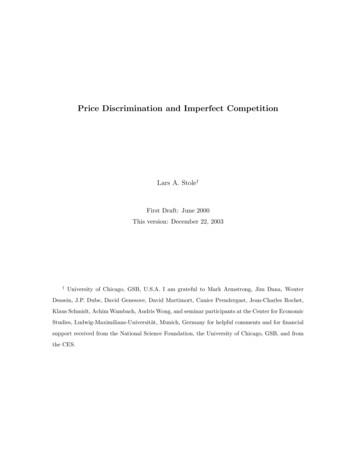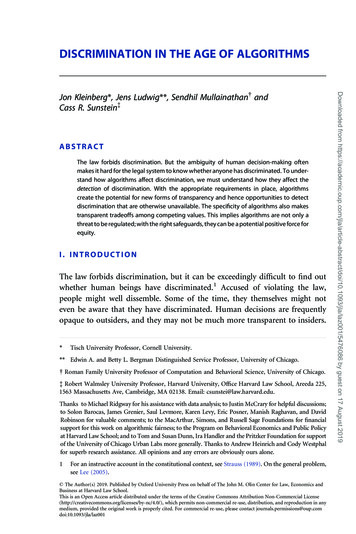
Transcription
DISCRIMINATION IN THE AGE OF ALGORITHMSABSTRACTThe law forbids discrimination. But the ambiguity of human decision-making oftenmakes it hard for the legal system to know whether anyone has discriminated. To understand how algorithms affect discrimination, we must understand how they affect thedetection of discrimination. With the appropriate requirements in place, algorithmscreate the potential for new forms of transparency and hence opportunities to detectdiscrimination that are otherwise unavailable. The specificity of algorithms also makestransparent tradeoffs among competing values. This implies algorithms are not only athreat to be regulated; with the right safeguards, they can be a potential positive force forequity.I. INTRODUCTIONThe law forbids discrimination, but it can be exceedingly difficult to find outwhether human beings have discriminated.1 Accused of violating the law,people might well dissemble. Some of the time, they themselves might noteven be aware that they have discriminated. Human decisions are frequentlyopaque to outsiders, and they may not be much more transparent to insiders.*Tisch University Professor, Cornell University.** Edwin A. and Betty L. Bergman Distinguished Service Professor, University of Chicago.y Roman Family University Professor of Computation and Behavioral Science, University of Chicago.z Robert Walmsley University Professor, Harvard University, Office Harvard Law School, Areeda 225,1563 Massachusetts Ave, Cambridge, MA 02138. Email: csunstei@law.harvard.edu.Thanks to Michael Ridgway for his assistance with data analysis; to Justin McCrary for helpful discussions;to Solon Barocas, James Grenier, Saul Levmore, Karen Levy, Eric Posner, Manish Raghavan, and DavidRobinson for valuable comments; to the MacArthur, Simons, and Russell Sage Foundations for financialsupport for this work on algorithmic fairness; to the Program on Behavioral Economics and Public Policyat Harvard Law School; and to Tom and Susan Dunn, Ira Handler and the Pritzker Foundation for supportof the University of Chicago Urban Labs more generally. Thanks to Andrew Heinrich and Cody Westphalfor superb research assistance. All opinions and any errors are obviously ours alone.1For an instructive account in the constitutional context, see Strauss (1989). On the general problem,see Lee (2005).ß The Author(s) 2019. Published by Oxford University Press on behalf of The John M. Olin Center for Law, Economics andBusiness at Harvard Law School.This is an Open Access article distributed under the terms of the Creative Commons Attribution Non-Commercial 4.0/), which permits non-commercial re-use, distribution, and reproduction in anymedium, provided the original work is properly cited. For commercial re-use, please contact Downloaded from 10.1093/jla/laz001/5476086 by guest on 17 August 2019Jon Kleinberg*, Jens Ludwig**, Sendhil Mullainathany andCass R. Sunsteinz
2 Kleinberg et al.: Discrimination In The Age Of Algorithms2See, e.g., McDonnell Douglas Corp. v. Green, 411 U.S. 792 (1973); Watson v. Fort Worth Bank & Trust,487 U.S. 977 (1988).3For a discussion of some of these issues in a legal setting, see Desai & Kroll (2017).4We employ this dichotomy—processes where decisions are made by algorithms and ones wheredecisions are made by humans—to make the issues clear. In practice, there can be a hybrid, withhumans overriding algorithmic judgments with their own. These hybrid processes will clearly havethe two elements of each process we describe here, with the additional observation that, with properregulation, we can see the exact instances where humans overrode the algorithm.Downloaded from 10.1093/jla/laz001/5476086 by guest on 17 August 2019A defining preoccupation of discrimination law, to which we shall devote considerable attention, is how to handle the resulting problems of proof.2 Thoseproblems create serious epistemic challenges, and they produce predictabledisagreements along ideological lines.Our central claim here is that when algorithms are involved, proving discrimination will be easier—or at least it should be, and can be made to be. Thelaw forbids discrimination by algorithm, and that prohibition can be implemented by regulating the process through which algorithms are designed. Thisimplementation could codify the most common approach to building machine-learning classification algorithms in practice, and add detailed recordkeeping requirements. Such an approach would provide valuable transparencyabout the decisions and choices made in building algorithms—and also aboutthe tradeoffs among relevant values.We are keenly aware that these propositions are jarring, and that they willrequire considerable elaboration. They ought to jar because in a crucial sensealgorithms are not decipherable—one cannot determine what an algorithm willdo by reading the underlying code. This is more than a cognitive limitation; it isa mathematical impossibility. To know what an algorithm will do, one must runit (Sipser 2012).3 The task at hand, though, is to take an observed gap, such asdifferences in hiring rates by gender, and to decide whether the gap should beattributed to discrimination as the law defines it. Such attributions need notrequire that we read the code. Instead, they can be accomplished by examiningthe data given to the algorithm and probing its outputs, a process that (we willargue) is eminently feasible. The opacity of the algorithm does not prevent usfrom scrutinizing its construction or experimenting with its behavior—twoactivities that are impossible with humans.4Crucially, these benefits will only be realized if policy changes are adopted,such as the requirement that all the components of an algorithm (including thetraining data) must be stored and made available for examination and experimentation. It is important to see that without the appropriate safeguards, theprospects for detecting discrimination in a world of unregulated algorithmdesign could become even more serious than they currently are.
2019: Volume 00, Number 0 Journal of Legal Analysis 35For a clear, recent treatment, see Barocas & Selbst (2016).6This point has been made by a large and growing literature in computer science. While the literatureis vast, some canonical papers include Dwork et al. (2012); Barocas & Selbst (2016), and the curatedset of studies assembled at Fairness, Accountability, and Transparency in Machine Learning (2019).7For one example, see Kleinberg et al. (2018).8There are clearly other kinds of algorithms and decisions, and they will require an independentanalysis.Downloaded from 10.1093/jla/laz001/5476086 by guest on 17 August 2019Our starting point is the current American legal system that has developed acomplex framework for detecting and regulating discriminatory decisions.5 It isincreasingly clear that this framework must be adapted for regulating the growing number of questions—involving hiring, credit, admissions, criminal justice—where algorithms are now involved in how public and private institutionsdecide.6 Algorithms provide new avenues for people to incorporate past discrimination, or to express their biases and thereby to exacerbate discrimination.Getting the proper regulatory system in place does not simply limit the possibility of discrimination from algorithms; it has the potential to turn algorithmsinto a powerful counterweight to human discrimination and a positive force forsocial good of multiple kinds.We aim here to explore the application of discrimination law to a particularlyimportant category of decisions: screening decisions, where a person (or set ofpeople) is chosen from a pool of candidates to accomplish a particular goal, aswhen college students are admitted on the basis of academic potential or defendants are jailed on the basis of flight risk.7 Algorithms can be used to produce predictions of the candidate’s outcomes, such as future performance afteracceptance of a job offer or admission to an academic program. We focus onone kind of machine-learning algorithm often applied to such problems, whichuses training data to produce a function that takes inputs (such as the characteristics of an applicant) and produces relevant predictions (id). The terminology here can be confusing since there are actually two algorithms: onealgorithm (the ‘screener’) that for every potential applicant produces an evaluative score (such as an estimate of future performance); and another algorithm(the ‘trainer’) that uses data to produce the screener that best optimizes someobjective function.8 The distinction is important and often overlooked; we shallemphasize it here.The existing legal framework for these types of screening decisions is necessarily shaped by practical considerations involving the typical difficulty of uncovering human motivations. Simply knowing that there is a disparity in hiringoutcomes is not enough to determine whether anyone has discriminated(McDonnell Douglas Corp. v. Green, 411 U.S. 792 (1973)). Perhaps there aregenuine differences in average performance across groups (Green 1999; Lee
4 Kleinberg et al.: Discrimination In The Age Of Algorithms9See, e.g., Corning Glass Works v. Brennan, 417 US 188 (1974).Downloaded from 10.1093/jla/laz001/5476086 by guest on 17 August 20192005). A central aspect of the legal challenge is to determine how and why thehiring decisions were made and whether protected personal characteristics,such as race and gender, played a role.9 Deciding whether there has been discrimination is difficult for one obvious and one less obvious reason. The obvious reason is generic to any legal system: people dissemble, obfuscate, and lie.The less obvious reason is that people may not even know themselves.A large body of research from behavioral science, described below, tells usthat people themselves may not know why and how they are choosing—even(or perhaps especially) when they think that they do (Nisbett & Wilson 1977).Many choices happen automatically; the influences of choice can be subconscious; and the rationales we produce are constructed after the fact and on thefly (Wilson 2004). This means that witnesses and defendants may have difficultyaccurately answering the core questions at the heart of most discriminationcases: What screening rule was used? And why? Even the most well-intentionedpeople may possess unconscious or implicit biases against certain groups(Banjali & Greenwald 2013).In contrast, a well-regulated process involving algorithms stands out for itstransparency and specificity: it is not obscured by the same haze of ambiguitythat obfuscates human decision-making. Access to the algorithm allows us toask questions that we cannot meaningfully ask of human beings. For any candidate, we can ask: “How would the screening rule’s decision have been different if a particular feature (or features) of the applicant were changed?” We canask exactly which data were made available for training the algorithm (andwhich were not), as well as the precise objective function that was maximizedduring the training. We will show that, as a result, we can attribute any observeddisparity in outcomes to the different components of the algorithm design orconclude that the disparity is due to structural disadvantages outside of thedecision process. In a nutshell: For the legal system, discovering “on what basisare they choosing?” and “why did they pick those factors?” becomes much morefeasible.It would be naı̈ve—even dangerous—to conflate “algorithmic” with “objective,” or to think that the use of algorithms will necessarily eliminate discrimination against protected groups (Barocas & Selbsst 2016). The reliance on datadoes not provide algorithms a presumption of truth; the data they are fed can bebiased, perhaps because they are rooted in past discrimination (as, for example,where past arrest records are used to predict the likelihood of future crime) (id.;Mayson 2019; Goel et al. 2019). It would also be naive to imagine that thespecificity of algorithmic code does not leave room for ambiguity elsewhere.
2019: Volume 00, Number 0 Journal of Legal Analysis 510 As another example, in some cases, humans may choose to override the algorithm and this re-introduces human ambiguity. It is worth noting here that we can see when these overrides arise.Downloaded from 10.1093/jla/laz001/5476086 by guest on 17 August 2019Algorithms do not build themselves. The Achilles’ heel of all algorithms is thehumans who build them and the choices they make about outcomes, candidatepredictors for the algorithm to consider, and the training sample. A criticalelement of regulating algorithms is regulating humans.10 Algorithms change thelandscape—they do not eliminate the problem.To make our ideas concrete, consider a case in which a real estate company isaccused of gender discrimination in hiring. Both sides agree that the firm hashired fewer women than men in the past but disagree on the reason: the firmcites differences in qualifications while the plaintiff cites discrimination. Ahighly stylized example of what might happen at trial: The plaintiff’s lawyerspoint to the fact that the plaintiff (like most female applicants to the firm) hasmore years of schooling than male applicants who were hired. The firm responds that while it weighs education, it also weighs years of work experience(and men have more); according to the firm, years of work experience are moreimportant. The plaintiff’s lawyers argue that work experience is being cited afterthe fact, as a pretext for why men were hired.Whether work experience is really the deciding factor is not readily discernible. Suppose that like many firms, this one does not use a formal quantitativerule; instead, it looks at each applicant holistically and forms a qualitative senseof who is likely the “best worker.” In these circumstances, the plaintiff’s lawyersmight call the managers involved in hiring to the stand, hoping one of them willrespond to questions in a way that reveals discriminatory intentions. Nonedoes. The plaintiff’s lawyers might also call employees who overheard misogynistic conservations by managers, hoping to show discriminatory intent, but letus stipulate that the conversations are not decisive. It is difficult to knowwhether the firm has, in fact, discriminated on the basis of gender.How might things have been different had the firm involved an algorithm intheir hiring process? In a well-regulated world with algorithms, the plaintiff’slawyers would ask for the screening and training algorithms, as well as theunderlying dataset used. Expert witnesses might be asked to analyze the screening rule; they would likely use statistical techniques that simulate counterfactuals to evaluate how otherwise similar applicants of different genders aretreated. Suppose that they discover no disparate treatment; men and womenare not being treated differently. But suppose too that the experts observe thatthe algorithm was given a fairly specific objective in its training procedure—predict sales over the employee’s first year. The use of this objective has a
6 Kleinberg et al.: Discrimination In The Age Of Algorithms1.1 Implications of Our FrameworkFive points are central to our analysis of discrimination law in an age of algorithms. First, the challenge of regulating discrimination is fundamentally one ofattribution. When a screening process produces a disparity for a particulargroup, to what do we attribute that gap? It could come from the screeningrule used. Perhaps the screening rule explicitly takes account of gender. Perhapsthe chosen objective—the outcome the screening rule aims to optimize—disadvantages women (or some other protected group). Perhaps the disparitycomes from the set of inputs made available to the screener. Perhaps the screening rule fails to optimize for a given outcome using the inputs. The answers tothese questions may or may not be relevant, depending on what the pertinentlaw considers to be “discrimination.”Importantly, the disparity may not result from any of these problems withthe screening rule itself. It could also be the consequence of average differencesin the outcome distributions across groups. For example, if some groups trulyhave worse access to K-12 schooling opportunities—perhaps their schools havelower levels of resources—then their college application packets may be lessstrong on average. Decomposing the source of disparities in screening decisionscan be enormously difficult, but it is critical for determining when legal remedies should be applied, and which ones.Second, this decomposition becomes easier once an algorithm is in the decision loop. Now the decisions we examine are far more specific than “why wasthis particular candidate chosen?” For example, a key input into the trainingalgorithm is a choice of objective—given the data, the trainer must produce ascreening rule that identifies people predicted to do well on some outcome (forexample, salespeople expected to have the highest revenues generated).Algorithms are exceedingly sensitive to these choices (Kleinberg et al. 2018).In searching for discrimination, the legal system may or may not make it important to ask, “Was the training algorithm given an appropriate outcome topredict?” It should be emphasized that the ability even to ask this question is aDownloaded from 10.1093/jla/laz001/5476086 by guest on 17 August 2019disparate impact on women. Can that impact be justified under the relevantlegal standard, such as business necessity? An analysis of the algorithm might beuseful in answering that question as well. It might be able to show that otherobjectives, such as sales over the first two years, would not have a disparateimpact. Moreover, hiring workers with this as the objective is shown to havelittle net effect on the firm’s total sales overall. If so, it would seem difficult forthe employer to defend its choice of its objective.
2019: Volume 00, Number 0 Journal of Legal Analysis 711 We are bracketing, for the moment, the question whether that is legally relevant.12 One possible response to this example is to argue that if the data contain bias, we simply should notuse them at all. But in many applications, it is difficult to imagine any alternative to data-drivendecision-making. In the case of mortgage lending, for instances, absent information about thecurrent income or assets of a borrower, or prior repayment history, on what basis should alender decide risk? A middle-ground approach might be only to use those data that are not sobiased, but as argued above, the algorithm has a much greater chance of being able to tell which dataelements contain a differential signal for one group relative to another than would any human being.Downloaded from 10.1093/jla/laz001/5476086 by guest on 17 August 2019luxury: instead of trying to infer why a salesperson was hired, the algorithm’sobjective function provides us with such information.The luxury of this knowledge unlocks the power of scrutiny: was this a reasonable choice of outcome?11 The same point holds for the other key choices forthe trainer. Of course, the ability to obtain the relevant knowledge requires (andwe argue for) a high degree of transparency. At a minimum, these records anddata should be stored for purposes of discovery. Algorithms do not only provide the means to scrutinize the choices we make in building them, but they alsodemand that scrutiny: it is with respect to these choices that human bias cancreep into the algorithm.Third, such scrutiny pays a dividend: if we regulate the human choiceswell, we might be willing to be more permissive towards how the algorithmuses information about personal attributes in certain ways. When we ensurehuman choices are made appropriately, some of the concerns that animatethe existing legal framework for human discrimination are rendered mootfor the algorithm. Suppose, for example, that college applications requirerecommendations from high school teachers. Any racial bias by teacherscould lead to differences in average letter quality across race groups.Interestingly, in some cases, the best way to mitigate the discriminatoryeffects of biased data is to authorize the algorithm to have access to information about race (Kleinberg, Ludwig et al. 2018; Gillis & Spiess 2019). To seewhy, note that only an algorithm that sees race can detect that someone froma given group has better college grades than their letters would suggest, andthen adjust predicted performance to address this disparity. Yet much ofthe time, considerations of factors like race is what antidiscrimination lawseeks to prevent (though in this setting, the legal result is not entirelyclear) (Loving v. Virginia, 388 U.S. 1 (1967); Miller v. Johnson, 515 U.S.800, 811 (1995)).12Fourth, algorithms will force us to make more explicit judgments aboutunderlying principles. If our goals are in tension—as, for example, if admittingmore minority students into an elite college would reduce first-year GPAs
8 Kleinberg et al.: Discrimination In The Age Of Algorithms13 See infra for details.14 We are building on an emerging line of research connected to developments in computer science,including valuable recent work by Barocas and Selbst (2016) that seeks to situate algorithms withinthe framework of discrimination law.Downloaded from 10.1093/jla/laz001/5476086 by guest on 17 August 2019because of disparities in K-12 school quality or other structural disadvantages—the algorithm precisely quantifies this tradeoff. And we must now articulate achoice. What tradeoff do we find acceptable? We will now be in a position tograpple with such questions quantitatively.13Our fifth and final point is that if appropriate regulation can protect againstmalfeasance in their deployment, then algorithms can become a potentiallypowerful force for good: they can dramatically reduce discrimination of multiple kinds. A variety of research shows that unstructured decision-making isexactly the sort of environment in which implicit biases can have their biggestimpact (Yang 2015; Cohen & Yang 2018). Of course it is true that in building analgorithm, human beings can introduce biases in their choice of objectives anddata; importantly, they might use data that are themselves a product of discrimination. But conditional on getting objectives and data right, the algorithmat least removes the human bias of an unstructured decision process. Thealgorithm, unlike the human being, has no intrinsic preference for discrimination, and no ulterior motives.And this might not even be the source of the most important gains fordisadvantaged groups. In many contexts, efficiency improvements alone havelarge disparate benefits for members of such groups. For example, Kleinberget al. (2018) examine pre-trial release decisions in New York, and find thatalgorithms better distinguish low-risk from high-risk defendants. By prioritizing the highest-risk people to detain, it becomes feasible in principle to jail 42%fewer people with no increase in crime (id.). The biggest benefits would accrueto the two groups that currently account for nine of every ten jail inmates:African-Americans and Hispanics.We develop these points at length, beginning with an exploration of discrimination law, the relevance of principles from behavioral science, and the tensions introduced into this framework by the use of algorithms.14 Our centralclaim, stated in simple form, is that safeguards against the biases of the peoplewho build algorithms, rather than against algorithms per se, could play a keyrole in ensuring that algorithms are not being built in a way that discriminates(recognizing the complexity and contested character of that term). If we dothat, then algorithms go beyond merely being a threat to be regulated; they canalso be a positive force for social justice.
2019: Volume 00, Number 0 Journal of Legal Analysis 92. THE LAW OF DISCRIMINATION: A PRIMER2.1 Disparate TreatmentThe prohibition on disparate treatment reflects a commitment to a kind ofneutrality (Brest 1976). For example, public officials are not permitted tofavor men over women or white people over black people. Civil rights statutesforbid disparate treatment along a variety of specified grounds, such as race, sex,national origin, religion, and age.17In extreme cases, the existence of disparate treatment is obvious, because afacially discriminatory practice or rule can be shown to be in place (“no womenmay apply”) (Reed v. Reed, 404 U.S. 71 (1971)). In other cases, no such practiceor rule can be identified, and for that reason, violations are more difficult topolice (Bartholet 1982; Jolls & Sunstein 2006). A plaintiff might claim that afacially neutral practice or requirement (such as a written test for employment)was actually adopted in order to favor one group (whites) or to disfavor another(Hispanics) (Washington v. Davis, 426 U.S. 229 (1976)). To police discrimination, the legal system is required to use what tools it has to discern the motivation of decision-makers.18 To paraphrase the Supreme Court, the keyquestion under the Equal Protection Clause is simple: Was the requirement orpractice chosen because of, rather than in spite of, its adverse effects on relevantgroup members? (Personnel Adm’r of Massachusetts v. Feeney, 442 U.S. 25615 For helpful discussion, see Franklin (2012); Bartholet (1982); Mendez (1980).16 See, e.g., Griggs v. Duke Power Co., 401 U.S. 424 (1971); Meacham v. Knolls Atomic Power Lab., 554U.S. 84 (2008). In the context of age discrimination, see Smith v. City of Jackson, 544 U.S. 229 (2005).For discussion, see Rutherglen (2006); Primus (2003); Bagenstos (2006, p. 4); Selmi (2006, pp.732-745). For objections, see Gold (1985).17 See, e.g., 42 U.S.C. § 2000e-2 (“It shall be an unlawful employment practice for an employer - (1) tofail or refuse to hire or to discharge any individual, or otherwise to discriminate against any individual with respect to his compensation, terms, conditions, or privileges of employment, because ofsuch individual’s race, color, religion, sex, or national origin.”).18 A defining framework can be found in McDonnell Douglas Corp. v. Green, 411 U.S. 792 (1973). SeeGreen (1999).Downloaded from 10.1093/jla/laz001/5476086 by guest on 17 August 2019Discrimination law has long been focused on two different problems. The firstis disparate treatment; the second is disparate impact. The Equal ProtectionClause of the Constitution (Vasquez v. Hillery, 474 US 254 (1986)), and allcivil rights laws, forbid disparate treatment.15 The Equal Protection Clause ofthe Constitution does not concern itself with disparate impact (Washington v.Davis, 426 US 229 (1976); McCleskey v. Kemp, 481 US 279 (1987)), but somecivil rights statutes do.16
10 Kleinberg et al.: Discrimination In The Age Of Algorithms2.2 Disparate ImpactThe prohibition on disparate impact means, in brief, that if some requirementor practice has a disproportionate adverse effect on members of protectedgroups (such as women and African-Americans), the defendant must showthat the requirement or practice is adequately justified.22 Suppose, for example,that an employer requires members of its sales force to take some kind ofwritten examination, or that the head of a police department institutes a rulerequiring new employees to be able to run at a specified speed. If these practiceshave disproportionate adverse effects on members of protected groups, they willbe invalidated unless the employers can show a strong connection to the actualrequirements of the job (Griggs v. Duke Power Co., 401 U.S. 424 (1971).2319 We are bracketing some of the differences between the Equal Protection Clause and the civil rightsstatutes. On the latter, see Green (1999).20 The classic discussion of taste-based discrimination is Becker (1971). On statistical discrimination,see Phelps (1972). On the difference, see Guryan & Charles (2013); Sunstein (1991).21 This is a clear implication of Craig v. Boren, 429 US 190 (1976), and JEB v. Alabama ex rel. TB, 511U.S. 127 (1994). For some complications, see Nguyen v. INS, 533 U.S. 53 (2001); Donohue III(2006).22 The defining decision is Griggs v. Duke Power Co., 401 U.S. 424 (1971). For our purposes, the fullintricacies of the doctrine do not require elaboration. See sources cited in footnote 16 for discussion.23 The disparate impact standard is now under constitutional scrutiny, but we bracket those issueshere. See Primus (2003).Downloaded from 10.1093/jla/laz001/5476086 by guest on 17 August 2019(1979)). That question might be exceedingly challenging to answer, but the lawmakes it necessary to try.19It is important to see that the disparate treatment idea applies whether discrimination is taste-based or statistical.20 An employer might discriminate (1)because he himself prefers working with men to working with women; (2)because the firm’s coworkers prefer working with men to working withwomen; or (3) because customers prefer men in the relevant positions. In allof these cases, disparate treatment is strictly forbidden (Strauss 1991). Or suppose that an employer is relying on a statistical demonstration that (for example) women leave the workforce more frequently than men do, or thatwomen over 50 are more likely than men over 50 to leave within ten years.Even if the
z Robert Walmsley University Professor, Harvard University, Office Harvard Law School, Areeda 225, 1563 Massachusetts Ave, Cambridge, MA 02138. Email: csunstei@law.harvard.edu. . We aim here to explore the application of discrimination law to a particularly important category of decisions: screening decisions, where a person (or set of


